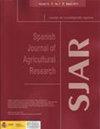Crop load management in high density apple plantation
IF 0.8
4区 农林科学
Q3 AGRICULTURE, MULTIDISCIPLINARY
引用次数: 0
Abstract
Aim of study: To optimize the best thinning method and elucidate its effect on fruit size, quality, yield and return bloom in apple under high density plantation in sub-temperate zone of India. Area of study: Dr. Yashwant Singh Parmar University of Horticulture and Forestry, Nauni, Solan, Himachal Pradesh, India. Material and methods: The experiment consisted of 30 combinations of 10 thinning (chemical and manual) treatments (T1: 10 mg L-1 NAA; T2: 20 mg L-1 NAA; T3: 100 mg L-1 BA; T4: 200 mg L-1 BA; T5: 100 mg L-1 Metamitron; T6: 200 mg L-1 Metamitron; T7: crop load of 4 fruits cm-2 TCSA; T8: crop load of 6 fruits cm-2 TCSA; T9: crop load of 8 fruits cm-2 TCSA and T10: control - no thinning) and 3 cultivars treatments (‘Jeromine’, ‘Redlum Gala’ and ‘Super Chief’), replicated five times over three growing seasons (2020 to 2022). Main results: The highest return bloom, fruit size, red skin color (RSC), sugars content, and anthocyanin content were produced due to manual thinning while maintaining a crop load of 4-6 fruits cm-2 TCSA (trunk cross sectional area). ‘Jeromine’ cultivar produced fruits with better yields, productivity, and RSC. ‘Redlum Gala’ had fruits with a better extent of thinning, return bloom, and sugar content. The extent of thinning showed a significant positive correlation with return bloom, fruit quality and physicochemical parameters, and growth in apples under high-density plantations. Research highlights: A possible threshold for optimal fruit quality and consistent return bloom is around 4-6 fruits cm-2 TCSA in apple under high density plantation in India.高密度苹果园作物负荷管理
研究目的:优化印度亚温带高密度种植下苹果的最佳间伐方法,研究间伐方法对苹果果实大小、品质、产量和回春的影响。研究领域:Dr. Yashwant Singh Parmar园艺和林业大学,印度喜马偕尔邦索兰瑙尼。
材料与方法:试验采用10种稀释(化学和人工)处理30种组合(T1: 10 mg L-1 NAA;T2: 20 mg L-1 NAA;T3: 100 mg L-1 BA;T4: 200 mg L-1 BA;T5: 100 mg L-1 Metamitron;T6: 200 mg L-1 Metamitron;T7: 4个果实cm-2 TCSA的作物负荷;T8: 6个果实cm-2 TCSA的作物负荷;T9: 8个果实cm-2 TCSA的作物负荷,T10:对照-不间伐)和3个栽培处理(' Jeromine ', ' Redlum Gala '和' Super Chief '),在三个生长季节(2020年至2022年)重复5次。主要结果:在保持4-6个果实cm-2 TCSA(树干横截面积)的作物负荷的情况下,人工间伐产生了最高的开花、果实大小、红皮颜色(RSC)、糖含量和花青素含量。‘Jeromine’品种的果实产量、生产力和RSC都较好。“红高粱”的果实疏化程度、返花程度和含糖量都较好。间伐程度与高密度人工林下苹果复花、果实品质、理化参数及生长均呈显著正相关。
研究重点:在印度高密度种植下,苹果最佳果实质量和持续开花的可能阈值约为4-6个果实cm-2 TCSA。
本文章由计算机程序翻译,如有差异,请以英文原文为准。
求助全文
约1分钟内获得全文
求助全文
来源期刊

Spanish Journal of Agricultural Research
农林科学-农业综合
CiteScore
2.00
自引率
0.00%
发文量
60
审稿时长
6 months
期刊介绍:
The Spanish Journal of Agricultural Research (SJAR) is a quarterly international journal that accepts research articles, reviews and short communications of content related to agriculture. Research articles and short communications must report original work not previously published in any language and not under consideration for publication elsewhere.
The main aim of SJAR is to publish papers that report research findings on the following topics: agricultural economics; agricultural engineering; agricultural environment and ecology; animal breeding, genetics and reproduction; animal health and welfare; animal production; plant breeding, genetics and genetic resources; plant physiology; plant production (field and horticultural crops); plant protection; soil science; and water management.
 求助内容:
求助内容: 应助结果提醒方式:
应助结果提醒方式:


